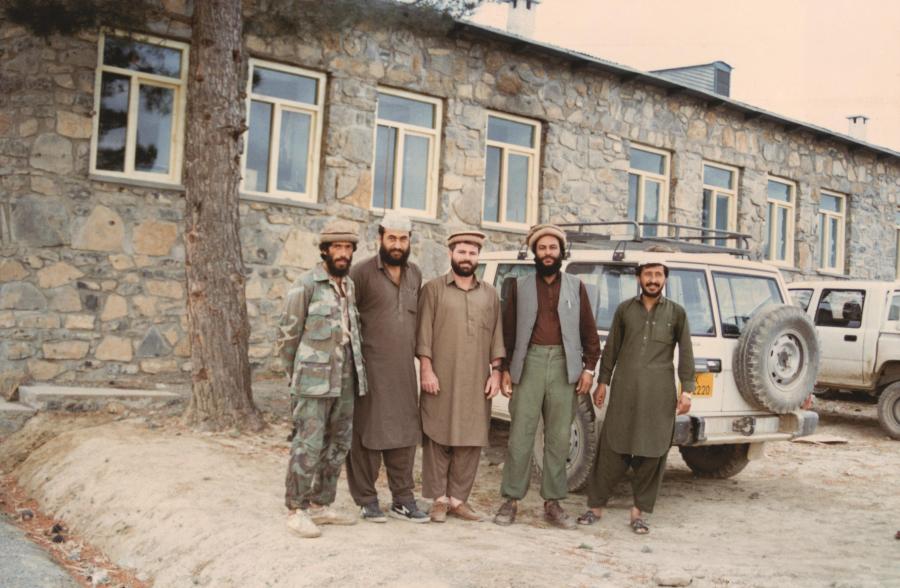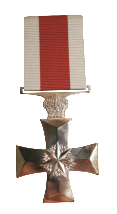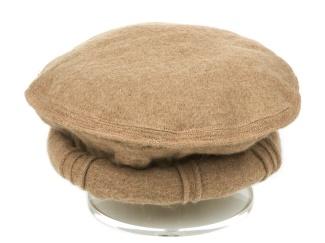Lieutenant Colonel Harold Jarvie

Like the locals, Harry (third from left) grew a beard and often dressed in local robes known as salwar kameez. (Photograph courtesy of Harry Jarvie)
An explosion rang out over the harsh Afghan landscape. A young boy lay motionless on the ground. Before Captain Harold Jarvie could get to him, he had to cross a minefield filled with dangerous unexploded material. Harold had to get there – but how?
Born in the small Western Australian town of Southern Cross on 21 April 1966, Harold James Jarvie was the youngest of eight children. He grew up near the Swan River in Perth, and he and his mates spent many hours swimming and jumping off the Guildford Road Bridge, often trying to splash tourists taking cruises up the river.
As a young man, Harry worked as a labourer and bank worker before joining the army in 1986. He graduated from the Royal Military College, Duntroon, in 1987, and was appointed to the Royal Australian Engineers.
In late 1992, after many engineering exercises and various command and training positions, Harry was posted as a technical adviser to the UN Mine Clearance Training Team (UNMCTT) in Pakistan and Afghanistan. The Soviet invasion of Afghanistan in 1979, and the ten years of fighting that followed, had left the country littered with more than ten million mines and other dangerous unexploded materials. Several million Afghans had been displaced, unable to return home from nearby Pakistan and Iran because of the threat of mines.
Observed by members of UNMCTT, local Afghans practise placing charges alongside mines to detonate them. (Marcus Fielding)
With many thousands of lives already lost to mines in Afghanistan, the UNMCTT, under Operation Salaam (which means “peace”), had many roles. They monitored mine-affected areas, and trained civilians in mine awareness and the basic procedures of mine clearance. UNMCTT members grew beards and dressed in local robes to assimilate with and gain the trust and respect of the locals. They taught de-mining courses, accompanied locals on training missions, and, in Harry’s case, assessed de-mining methods and surveyed minefields for later clearance.
During one survey mission near a minefield on 23 August 1993, Harry and his colleague Lieutenant Colonel Greg McDowall heard a mine explode. Told that a young Afghan boy had been badly injured, the pair hurried to the area. They followed a local guide along a goat track through an uncleared minefield to reach the boy, and did their best to ease his pain. While Greg organised his evacuation to a nearby medical facility, Harry applied first aid and helped lift him onto a stretcher.
The boy did not survive. For his actions Harry was awarded a Land Commander’s Commendation, which stated: “I commend you for your courage in entering the unsurveyed lane through the minefield, and for your calm and competent handling of a critical first aid situation.”[1]
When Harry left Afghanistan in late 1993, the mine clearance program was well established. It was able to continue on a local level, with the help of external advisers and former UNMCTT members.
At the UN de-mining training camp in Pakistan, large tents served as lecture theatres. Members of UNMCTT instructed Afghan and Pakistani personnel in first aid and mine-clearance procedures. (Marcus Fielding)
After returning to Australia, Harry married Helen Rankin in October 1998. The pair moved to Queenscliff, Victoria, where Harry attended Command and Staff College. They had their son in 2000.
Their daughter was born a year later, while Harry was deployed to East Timor. For his command of the Engineer Component of 4RAR Battalion Group Harry was awarded a Commendation for Distinguished Service. He went on to serve in Iraq, where he organised the training of new local Security Forces and served with Headquarters Land Command Engineers, for which he was awarded the Conspicuous Service Cross.
In 2007 Harry commanded Reconstruction Task Force 2, which helped build medical centres, schools, and bridges in southern Afghanistan, despite constant threats and violence from the Taliban. He was awarded the Distinguished Service Cross for his leadership in action in 2008.

The Distinguished Service Cross recognises leadership and command in military action. (Photograph courtesy of Harry Jarvie)
Today, Harry lives with his family in northern New South Wales, and still serves in the Army Reserve at the Army’s Combat Training Centre.
In 2013, Harry spoke of his service in Afghanistan:
I often reflect on the tragedy that is Afghanistan, particularly the devastation that the landmines and other explosive hazards have inflicted on the civilian population of Afghanistan, and the one young boy I attempted to help, who I will always remember.[2]
Activities
- The photograph below shows an Afghani pakul cap.
- Why did UNMCTT members wear these caps and robes, in addition to growing beards during their service
- What other cultural considerations may servicemen and servicewomen need to consider when they deploy to foreign countries?

An Afghani pakul cap. These caps were worn by members of UNMCTT during their service in Afghanistan.
- The Soviet invasion of Afghanistan in 1979, and the ten years of fighting that followed, left the country littered with more than ten million mines and other dangerous unexploded materials. One of the roles of the UNMCTT was to train locals in mine awareness.
- What would have been important to include in this training?
- What is the picture on the front of the pack below showing?
- Do you think images or text would be more beneficial in teaching locals about mine awareness? Why?
The cover of a United Nations mine-awareness pack used by the UNMCTT to teach locals about mines in Afghanistan and Pakistan
Related objects
Footnotes
[1] Land Commander’s Commendation, from the private collection of Harold J. Jarvie. Reproduced with permission.
[2] Email from Harry J. Jarvie, 17 September, 2013.
Bibliography
David Horner (ed.), Australia and the “New World Order”: from peacekeeping to peace enforcement: 1988–1991, vol. II, The Official History of Australian Peacekeeping, Humanitarian and Post–Cold War Operations, Melbourne, 2011.


